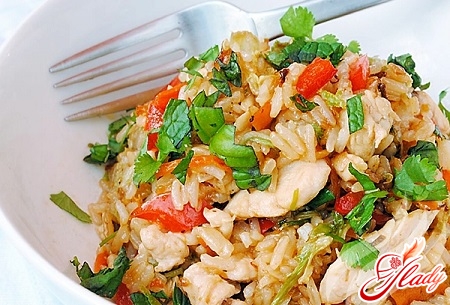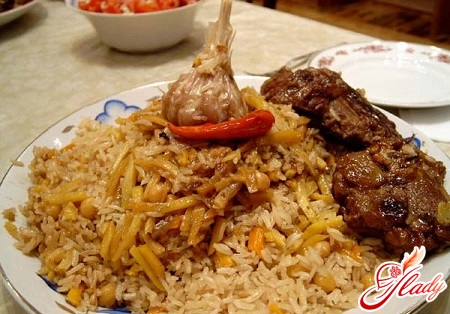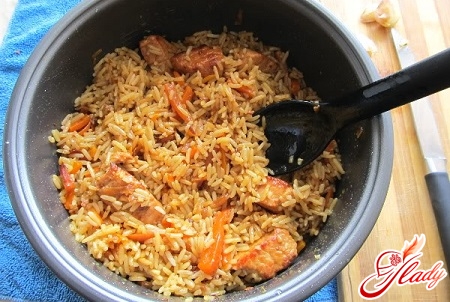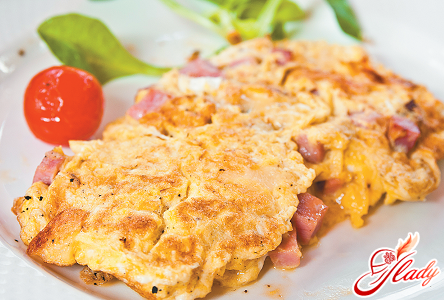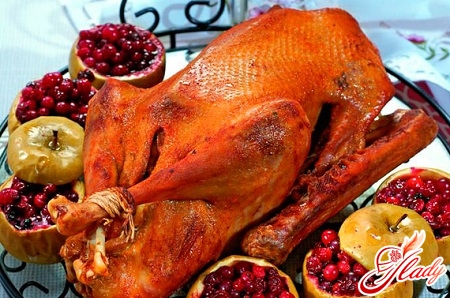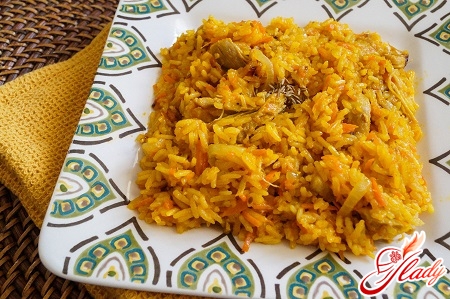
It is known that one of the "royal"dishes of oriental cuisine is pilaf. This dish is loved by the vast majority of people of any nationality. There are many varieties of pilaf. In Tajik cuisine, for example, there are more than a dozen of its types. In order for pork pilaf to be crumbly and tasty, there are some rules that should be followed to achieve the best result.
Where the first plov
Plov is such an ancient dish thatIt was first mentioned in the epics and folk tales of Central Asia. The famous ancient healer Abu Ali ibn Sina recommended this dish for ailments and some minor illnesses. At that time, pilaf was considered an expensive food and rarely appeared on the table of the poor. And wealthy people proudly treated their guests to it. In Uzbekistan, this dish of rice and meat is called "palov osh". Linguists believe that this phrase is related to the Greek language, which contains the word "poluv", that is, varied composition. It is difficult to say how true this hypothesis is, but it is opposed by the fact that in the national Greek cuisine there is no such dish as pilaf. Each favorite dish or drink has a legend telling about its origin. Plov did not escape this fate. The most beautiful story of its origin belongs to the Uzbek people and dates back to the times of the Bukhara Khanate. It tells of the unhappy love of the son of the ruler of Bukhara for the daughter of a poor craftsman. The prince stopped eating and sleeping out of melancholy. To find out the reason for his son's condition, the ruler called ibn Sina. He quickly figured out what was going on and ordered the man who knew the city well to list the names of its quarters. The doctor himself monitored the prince's pulse all the time. When the area where his beloved lived was named, the young man became agitated and his pulse quickened. The craftsman was found in the same way. To restore his strength before the wedding, ibn Sina prescribed the prince to eat "palov osh". Thus, the famous Uzbek pilaf began its march across the country.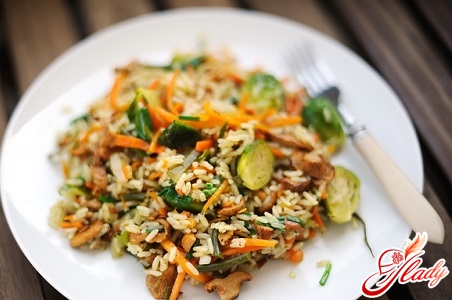
How to choose rice for pilaf
Rice is the main ingredient of any pilaf.You can choose any meat for this dish, including chicken, and you can also experiment with rice. A competent housewife understands that if you do not understand the varieties of rice, then instead of pilaf you can cook porridge. But if she wants to make crumbly delicious pilaf from pork, then it is best to choose long-grain rice. It is most often used in Uzbek cuisine. Such varieties as Khan and Pakistani are very good in pilaf. A dish that contains ordinary round rice will be more sticky, but no less tasty. When choosing rice, you should carefully examine the package for rice crumbs and powder. You should know that brittle varieties of this cereal are not suitable for pilaf. It would be a good idea to read the inscriptions on the package. This will help you avoid a mistake and not buy steamed rice. The dish with it will be bland and tasteless. If the grain is steamed, the inscription Parboiled will indicate this. In eastern countries, it is believed that the optimal choice would be yellowish, slightly transparent coarse-grain rice.
Ways of cooking rice for pilaf
To prepare pork pilaf you need riceeither raw or in a folded form. Of course, in any of the options, the cereal should be sorted out and washed well, repeatedly changing the water. No one will have any difficulties with laying raw rice, but with folded rice everything is a little more complicated. The fact is that in some types of pilaf (most often, when it is cooked at home), the rice is pre-boiled until half-ready. To do this, the cereal is poured with a large amount of salted boiling water and cooked over low heat for a short time, only 10 minutes. You can also cook in a mixture of water and milk in a ratio of 50:50. In some cases, the oil required by the recipe is added to the boiling water. This method is suitable for crumbly pilaf. If Khan or Pakistani rice is chosen for the dish, there is a special method of preparation for it. First of all, the cereal should be thoroughly washed and sorted out. Then, take a saucepan and put 2-3 tablespoons of salt wrapped in a piece of cloth on its bottom. It should not have any lint or coloring components. Then, pour the prepared cereal on top of this bundle and fill it with cold water. Let it sit for at least 8-10 hours. After this time, take the rice out and rinse it well. Now it is ready to be added to the pilaf, which will turn out very tasty. The most delicious rice, as they say in the East, is obtained as follows: the cereal is sorted, rinsed and soaked in cold water for 20 minutes. Then the rice needs to be allowed to dry, for which it is thrown into a colander. Next, it should be mixed with hot oil in a cauldron and fried until the grains become somewhat transparent. Then, when the cereal has cooled down, it should be poured with salted boiling water or meat broth, also boiling. It is imperative to observe the proportion of 1: 1.5, where the last number indicates the amount of water. Then the cereal should be cooked for a few minutes over high heat, after placing a weight on the lid of the cauldron. After that, the heat is reduced and the rice is cooked until all the liquid has evaporated. In Central Asia, they believe that such pilaf will be the most authentic.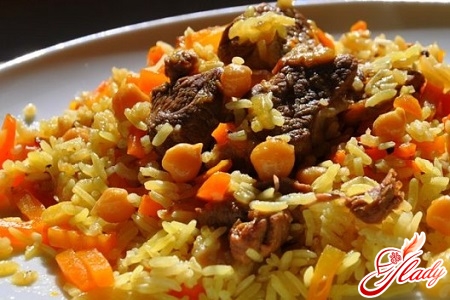
Choosing pork for pilaf
To cook real pilaf at home, you needknow which part of the carcass is most suitable for this purpose. The best option would be to choose the pulp, which has little sinew and fat. Pilaf with pork on the bone has a unique taste and aroma. The neck or under-neck are perfect for this dish. Some housewives prefer to make pilaf on pork ribs. In short, any piece of meat that does not have too much fat will do. Fresh pork is pink. If the meat looks slightly dry and has a thin crust, this does not mean that it is not suitable for food. However, you need to pay attention to the fact that there are no spots of a different color on it. If you put your hand to fresh pork, it should remain almost dry. In the event that mucus is noticeable, then it is better not to buy such meat. You should also pay attention to its smell. In order for the meat to retain all its taste, it should be defrosted only at room temperature, and not under warm running water. Pork is often quite fatty, so all the fat and films need to be cut off. If there are sinews, they are also removed. Then the fillet is cut into small pieces. If ribs are chosen, they should be chopped and washed so that small bone fragments do not get into the pilaf. Before laying, the meat needs to be washed and thrown into a colander, since moisture will be excessive when frying pork with spices.
How to cook a real pilaf?
To prepare pilaf with pork you will needa cauldron or a saucepan with a thick bottom and walls. A deep thick-walled frying pan or a roasting pan with a non-stick coating will do. A very successful pilaf with pork is obtained in a multicooker. Every housewife knows that this dish can be prepared in different ways. There is no single solution to how to make a delicious pilaf with pork correctly. There are many recipes for very worthy dishes.
Seasonings and spices for pilaf
What seasonings and spices to use,depends on the pilaf recipe. Cumin and barberry are highly respected in Uzbek cuisine. No dish that includes rice and meat can do without them. If we consider recipes of European orientation, and not Eastern, then here most often we find ground black pepper and peas, paprika, coriander, bay leaf. Many people like to make pilaf from pork with the addition of dried fruits. In this case, it has a very unusual taste and excellent aroma. Seasonings and spices that are sold in glass containers are of higher quality, so they are a little more expensive. You can also buy ready-made seasoning mixes for pilaf, but they do not suit every housewife and are not suitable for all recipes. The finished dish is often sprinkled with herbs: cilantro, marjoram, basil. A simple recipe for pilaf with pork This dish uses only pork pulp, without bones. It should be cleaned of film and too soft and thin tissues should be cut off. These scraps will come in handy later. Then the pork needs to be washed, dried and cut into small cubes. To save time, you need to deal with the rice first. Wash the cereal and pour boiled water at room temperature over it for 40 minutes. You need enough water so that it slightly protrudes above the rice. While it swells, deal with the vegetables and meat. For 1 kg of pork, you need 350 g of rice, 0.5 kg of carrots and onions, a head of garlic, 2 tomatoes and 3 tablespoons of tomato paste. Since this recipe for pork pilaf is very simple, the seasonings and spices here are those that suit the taste of the hostess and her family. The onion is cut coarsely, into half rings, the carrots - into strips. Many people grate it, but this is not acceptable for pilaf. Use a sharp knife to peel the tomatoes and carefully cut them into medium-sized cubes. The garlic needs to be peeled and the cloves left whole. There is a little trick in this recipe: the chopped onion and carrot need to be mixed. Next, take the dish in which you decided to cook the pilaf, pour vegetable oil, preferably olive oil, into its bottom. You will need 250-300 g. Put a handful of onions and carrots into the boiling oil and fry. While the vegetables are starting to brown, put the meat trimmings into the pan. These should be fried very well. Then the oil is completely freed from all ingredients, which are simply thrown away. Now it is the turn of the pork, which is fried at the same heat for 20 minutes, stirring constantly. Then put in the remaining onions and carrots. Cover the pan with a lid and leave the meat and vegetables to stew for 7-9 minutes. Then add the tomatoes, stir, and stew the mixture of products again under the lid for 5 minutes. Now you need to pour boiling water into the frying pan so that it protrudes above the products by the thickness of your little finger. After the water boils, add tomato paste, salt and pepper. This entire mixture of products needs to be cooked for 10-15 minutes. During this time, you need to prepare the selected spices and, after the required time, add them to the frying pan along with the garlic cloves. After 5 minutes of stewing, add rice, which should be leveled. Now you need to make the lowest heat and cook the pilaf for 20-25 minutes.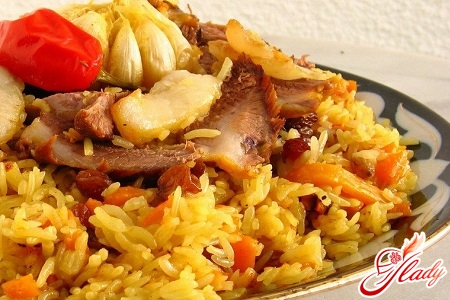 A complex recipe for pilaf with pork This method is fromconnoisseurs of oriental cuisine. It deliberately does not indicate the weight of the ingredients, but explains the patterns, the knowledge of which will help you make crumbly real oriental pilaf from pork at home. You need to take the same amount of meat, carrots and onions, and you can take 2 times more rice than pork. This dish must necessarily contain black cumin, dried barberry, paprika, turmeric and salt. The spices are pre-mixed in the right amount. As in the previous recipe, the rice must be soaked in cool boiled water for at least 40 minutes. Pour oil into the cauldron taking into account the fat content of the meat. If it is lean, then you need much more oil. It should be heated, but not overheated. You can determine the readiness of the oil in this way: you need to put half a small onion in it and wait until it browns. As soon as this happens, take the onion out with a slotted spoon. And put in the pork cut into pieces. While the meat is frying, cut the carrots into strips and the onion into half rings. Be sure to stir the pork occasionally. After 10 minutes of frying, add the onion to the meat and cook until golden brown. Now you need to put in the carrots and fry them with the onion and meat for 5 minutes, stirring constantly. Next, pour boiling water over the mixture of products so that it covers them by at least 1 cm. What is now in the cauldron is called zirvak - gravy for pilaf. You need to let it boil, add spices and put in the rice. Cover the cauldron with a lid, reduce the heat, and after 20 minutes the crumbly pilaf is ready. Serve it on a large open platter. Now you know how to cook pork pilaf at home.
A complex recipe for pilaf with pork This method is fromconnoisseurs of oriental cuisine. It deliberately does not indicate the weight of the ingredients, but explains the patterns, the knowledge of which will help you make crumbly real oriental pilaf from pork at home. You need to take the same amount of meat, carrots and onions, and you can take 2 times more rice than pork. This dish must necessarily contain black cumin, dried barberry, paprika, turmeric and salt. The spices are pre-mixed in the right amount. As in the previous recipe, the rice must be soaked in cool boiled water for at least 40 minutes. Pour oil into the cauldron taking into account the fat content of the meat. If it is lean, then you need much more oil. It should be heated, but not overheated. You can determine the readiness of the oil in this way: you need to put half a small onion in it and wait until it browns. As soon as this happens, take the onion out with a slotted spoon. And put in the pork cut into pieces. While the meat is frying, cut the carrots into strips and the onion into half rings. Be sure to stir the pork occasionally. After 10 minutes of frying, add the onion to the meat and cook until golden brown. Now you need to put in the carrots and fry them with the onion and meat for 5 minutes, stirring constantly. Next, pour boiling water over the mixture of products so that it covers them by at least 1 cm. What is now in the cauldron is called zirvak - gravy for pilaf. You need to let it boil, add spices and put in the rice. Cover the cauldron with a lid, reduce the heat, and after 20 minutes the crumbly pilaf is ready. Serve it on a large open platter. Now you know how to cook pork pilaf at home.




